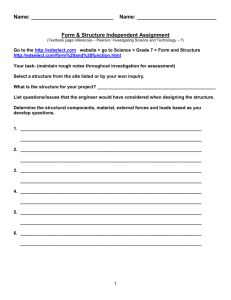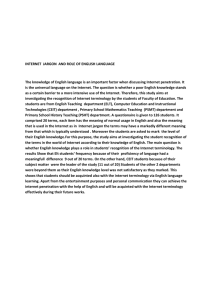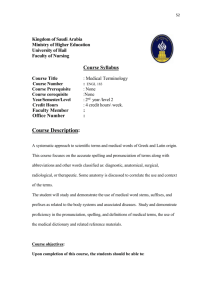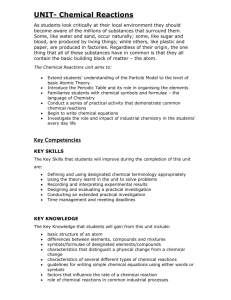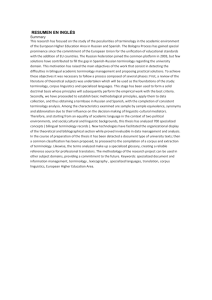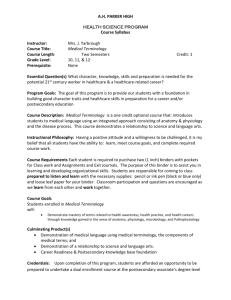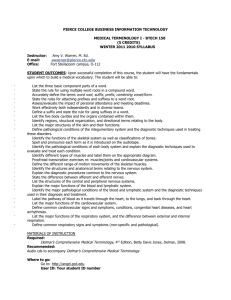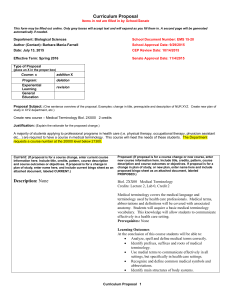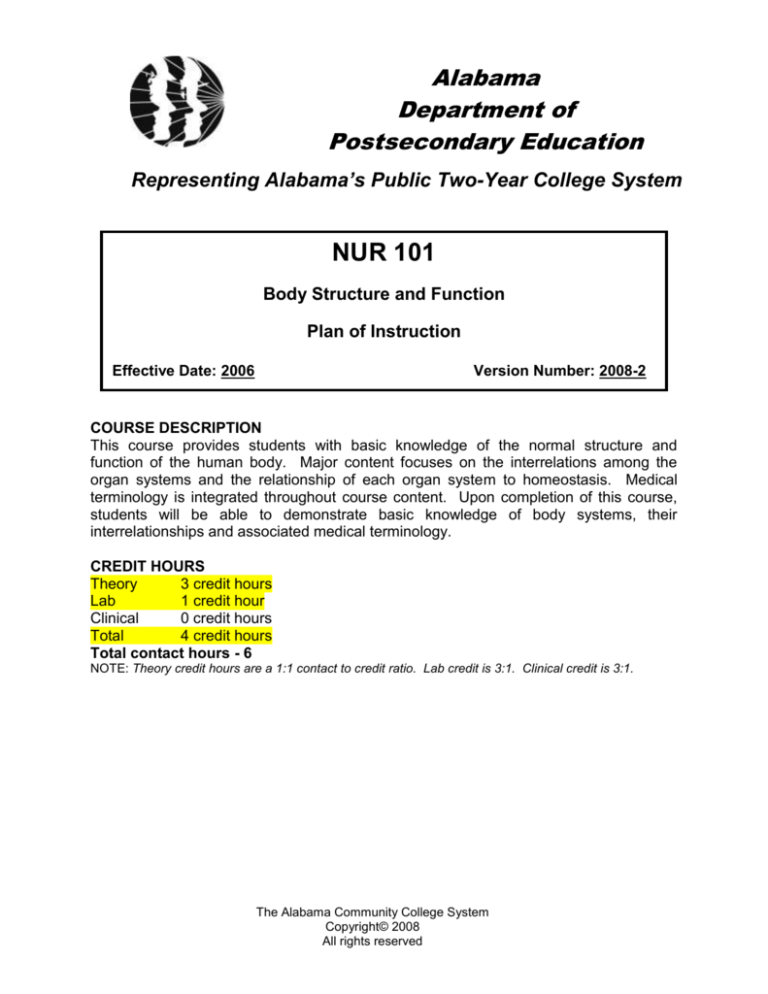
Alabama
Department of
Postsecondary Education
Representing Alabama’s Public Two-Year College System
NUR 101
Body Structure and Function
Plan of Instruction
Effective Date: 2006
Version Number: 2008-2
COURSE DESCRIPTION
This course provides students with basic knowledge of the normal structure and
function of the human body. Major content focuses on the interrelations among the
organ systems and the relationship of each organ system to homeostasis. Medical
terminology is integrated throughout course content. Upon completion of this course,
students will be able to demonstrate basic knowledge of body systems, their
interrelationships and associated medical terminology.
CREDIT HOURS
Theory
3 credit hours
Lab
1 credit hour
Clinical
0 credit hours
Total
4 credit hours
Total contact hours - 6
NOTE: Theory credit hours are a 1:1 contact to credit ratio. Lab credit is 3:1. Clinical credit is 3:1.
The Alabama Community College System
Copyright© 2008
All rights reserved
Body Structure and Function
NUR 101
PREREQUISITE COURSES
None
CO-REQUISITE COURSES
None
INSTRUCTOR NOTE: This course incorporates 15 hours of medical terminology.
INSTRUCTIONAL GOALS
Cognitive - Comprehend foundational knowledge of interrelationship of body
structure and function.
Psychomotor - There are no psychomotor objectives with this course.
Affective – There are no affective objectives directly associated with this course.
PROFESSIONAL COMPETENCIES/OBJECTIVES
Unless otherwise indicated, evaluation of student’s attainment of cognitive and
performance objectives is based on knowledge and skills gained from this course.
Competencies specified for each module may be set by certification agencies, national
and state codes, health care facility policies, locally developed lab/clinical assignments,
or any combination. Students are expected to utilize relevant technology for client care
and documentation.
PROFESSIONAL COMPETENCIES
Explain structure and function of the body
ACCS Copyright© 2008
All rights reserved
2
Body Structure and Function
NUR 101
MODULE A – BODY STRUCTURE AND FUNCTION
PROFESSIONAL COMPETENCIES
A1.0 Explain the structure and
function of the body.
PERFORMANCE OBJECTIVES
A1.1 Identify anatomical parts, planes, and
regions of the body and explain their
interrelationship.
LEARNING OBJECTIVES
A1.1.1 Define terms associated with the structure and function of the body.
A1.1.2 List organizational levels of the body in order of increasing complexity.
A1.1.3 Explain anatomical position.
A1.1.4 List anatomical directions.
A1.1.5 Explain anatomical directions.
A1.1.6 Explain the relationship of anatomical directional terms to the body.
A1.1.7 Identify planes or body sections.
A1.1.8 Explain planes or body sections.
A1.1.9 Identify body cavities and subdivisions of each.
A1.1.10 Identify body regions and subdivisions of each.
A1.1.11 Explain mechanisms to maintain homeostasis.
A1.1.12 Relate medical terminology to the structure and function of the body.
CLINICAL/LAB SKILLS
Body planes, cavities, and regions
Anatomical position
Anatomical directions
Structure levels of organization
MODULE A OUTLINE
Structure levels of organizations
Cells
Tissues
Organs
Systems
Anatomical position
Anatomical directions
Superior
Inferior
Anterior
Posterior
Medial
Lateral
Proximal
Distal
Superficial
Deep
Planes or body sections
Sagittal
Midsagittal
Frontal
Transverse
ACCS Copyright© 2008
All rights reserved
KSA
Indicators
B
A
A
B
A
B
B
A
B
A
A
B
B
3
Body Structure and Function
NUR 101
MODULE A OUTLINE (Continued)
Body cavities
Ventral
Dorsal
Body regions
Axial
o Regions
o Quadrants
Appendicular
The balance of body functions
Homeostasis
Feedback loops
Medical terminology
ACCS Copyright© 2008
All rights reserved
4
Body Structure and Function
NUR 101
MODULE B – CHEMISTRY OF LIFE
PROFESSIONAL COMPETENCIES
B1.0
PERFORMANCE OBJECTIVES
Explain the structure and
B1.1 Identify substances related to the
function of the body.
chemistry of the body.
LEARNING OBJECTIVES
B1.1.1 Define terms associated with the levels of chemical organization.
B1.1.2 Identify three kinds of particles within an atom.
B1.1.3 Differentiate between ionic bonds and covalent bonds.
B1.1.4 Differentiate between organic and inorganic compounds.
B1.1.5 Explain the difference between solvent and solute.
B1.1.6 Explain the concept of pH.
B1.1.7 Explain the difference between acid and base.
B1.1.8 Explain the structure and function of carbohydrates, proteins, lipids, and
nucleic acids.
B1.1.9 Relate medical terminology to chemistry of life.
CLINICAL/LAB SKILLS
pH testing
KSA
Indicators
B
A
A
B
B
B
B
B
B
B
MODULE B OUTLINE
Chemical Organization of life
Atom
Molecule
Cell
Tissue
Organ
Organ system
Organism
Atoms
Atomic composition
o Protons
o Neutrons
o Electrons
Bonding
o Ionic
o Covalent
ACCS Copyright© 2008
All rights reserved
5
Body Structure and Function
NUR 101
MODULE B OUTLINE (Continued)
Organic and Inorganic compounds
Solution Composition
o Solvent
o Solute
Solution Types
Electrolytes
o Acids
o Bases
o Salts
pH scale
Biochemical Compounds - Structure and Function
Carbohydrates
Lipids
Proteins
Nucleic Acids
Medical terminology
ACCS Copyright© 2008
All rights reserved
6
Body Structure and Function
NUR 101
MODULE C – CELLS AND TISSUES
PROFESSIONAL COMPETENCIES
C1.0 Explain the structure and function
of the body.
PERFORMANCE OBJECTIVES
C1.1 Identify specified characteristics
and functions of various cell and
tissue components.
KSA
Indicators
B
LEARNING OBJECTIVES
C.1.1.1 Define terms associated with cells and tissues.
C.1.1.2 Identify the parts of a cell.
C.1.1.3 Explain the structure and functions of organelles.
C.1.1.4 Identify the processes that move substances through cell membranes.
C.1.1.5 Compare the passive and active transport processes.
C.1.1.6 Explain the flow of fluids through the cell membrane.
C.1.1.7 Explain factors that affect tonicity.
C.1.1.8 Explain cellular reproduction.
C.1.1.9 Identify types of tissues.
C.1.1.10 Relate medical terminology to cells and tissues.
LAB SKILLS
Microscopic inspection of cells and tissues
Diffusion and osmosis
A
A
B
A
B
B
B
A
B
B
MODULE C OUTLINE
Cells
Size and shape
Composition
Parts of the cell
Relationship of cell structure and function
Movement of substances through cell membranes
Passive transport processes
Active transport processes
Tonicity
o Isotonic
o Hypotonic
o Hypertonic
Cell reproduction
DNA structure
Genetic code
Cell division
DNA replication
Mitosis
Stages of mitosis
Tissues
Epithelial
Connective
Muscle
Nervous
Medical terminology
ACCS Copyright© 2008
All rights reserved
7
Body Structure and Function
NUR 101
MODULE D – INTRODUCTION TO ORGAN SYSTEMS
PROFESSIONAL COMPETENCIES
D1.0 Explain the structure and function
of the body.
PERFORMANCE OBJECTIVES
D1.1 This module is measured
cognitively.
KSA
Indicators
B
LEARNING OBJECTIVES
D1.1.1 List the major organ systems.
D1.1.2 Explain the structure of each system.
D1.1.3 Explain the function of each system.
D1.1.4 Relate medical terminology to organ systems.
CLINICAL/LAB SKILLS
None
MODULE D OUTLINE
Integumentary
Structure – organs
o Skin
o Hair
o Nails
o Sense receptors
o Sweat glands
o Oil glands
Functions
o Protection
o Regulation of body temperature
o Synthesis of chemicals
o Sensory organs
o Skeletal
Structure
o Bones
o Joints
Functions
o Support
o Movement (with joints and muscles)
o Storage of minerals
o Blood cell formation
ACCS Copyright© 2008
All rights reserved
A
B
B
B
8
Body Structure and Function
NUR 101
MODULE D OUTLINE (Continued)
Muscular
Structures
o Muscles
Voluntary or striated
Involuntary or smooth
Cardiac
Functions
o Movement
o Maintenance of body posture
o Production of heat
Nervous
Structure
o Brain
o Spinal cord
o Nerves
o Sense organs
Functions
o Communication
o Integration
o Control
o Recognition of sensory stimuli
Endocrine
Structure
o Pituitary gland
o Pineal gland
o Hypothalamus
o Thyroid gland
o Parathyroid glands
o Thymus gland
o Adrenal glands
o Pancreas
o Ovaries (female)
o Testes (male)
Functions
o Communication
o Integration
o Control
Cardiovascular
Structure
o Heart
o Blood vessels
Functions
o Transportation
o Regulation of body temperature
o Immunity (body defense)
ACCS Copyright© 2008
All rights reserved
9
Body Structure and Function
NUR 101
MODULE D OUTLINE (Continued)
Lymphatic system and immunity
Structure
o Lymph nodes
o Lymphatic vessels
o Thymus
o Spleen
Functions
o Transportation
o Immunity (body defense)
Respiratory
Structure
o Nose
o Pharynx
o Larynx
o Trachea
o Bronchi
o Lungs
Functions
o Oxygen/Carbon dioxide transport
o Gas exchange
o Regulation of acid-base
Gastrointestinal
Structure
o Primary organs
Mouth
Pharynx
Esophagus
Stomach
Small intestine
Large intestine
Rectum
Anal canal
o Accessory organs
Teeth
Salivary glands
Tongue
Liver
Gallbladder
Pancreas
Appendix
Functions
o Breakdown
o Absorption
o Elimination
ACCS Copyright© 2008
All rights reserved
10
Body Structure and Function
NUR 101
MODULE D OUTLINE (Continued)
Urinary
Structure
o Kidneys
o Ureters
o Urinary bladder
o Urethra
Functions
o Excretion of waste
o Fluid and electrolyte balance
o Acid-base balance
Reproductive
Structure
o Male
o Female
Functions
o Propagation of species
o Secondary sex characteristics
Medical terminology
ACCS Copyright© 2008
All rights reserved
11
Body Structure and Function
NUR 101
MODULE E – INTEGUMENTARY SYSTEM AND BODY MEMBRANES
PROFESSIONAL COMPETENCIES
E1.0
Explain the structure and function
of the body.
PERFORMANCE OBJECTIVES
E1.1 Identify different structures and
functions of the integumentary
system.
LEARNING OBJECTIVES
E1.1.1 Define terms associated with the integumentary system.
E1.1.2 Identify types of body membranes.
E1.1.3 Describe the structure of the skin.
E1.1.4 Describe the function of the skin.
E1.1.5 Identify appendages of the skin.
E1.1.6 Identify impaired skin integrity.
E1.1.7 Relate medical terminology to the integumentary system.
LAB SKILLS
Microscopic inspection
Use of terminology
Impaired skin integrity
MODULE E OUTLINE
Classification of body membranes
Epithelial membranes
o Cutaneous membrane – the skin
o Serous membranes
o Mucous membranes
Connective tissue membranes
The skin
Structure
o Epidermis
o Dermis
Appendages
o Hair
o Receptors
o Nails
o Skin glands
Functions
o Protection
o Temperature regulation
o Sense organ activity
o Impaired skin integrity
Medical terminology
ACCS Copyright© 2008
All rights reserved
KSA
Indicators
B
A
B
B
B
A
A
B
12
Body Structure and Function
NUR 101
MODULE F – SKELETAL SYSTEM
PROFESSIONAL COMPETENCIES
F1.0 Explain the structure and function
of the body.
PERFORMANCE OBJECTIVES
F1.1 Identify different structures and
functions of the skeletal system.
KSA
Indicators
B
LEARNING OBJECTIVES
F1.1.1 Define terms associated with the skeletal system.
F1.1.2 Explain the functions of the skeletal system.
F1.1.3 Identify types of bones.
F1.1.4 Identify the anatomical structures found in long bones.
F1.1.5 Explain the microscopic structure of bone and cartilage.
F1.1.6 Explain bone formation and growth.
F1.1.7 Identify the two divisions of the skeletal system.
F1.1.8 List the bones found in the two divisions of the skeletal system.
F1.1.9 Differentiate between male and female skeletal structures.
F1.1.10 Identify types of joints.
F1.1.11 Differentiate the movements allowed by different types of joints.
F1.1.12 Relate medical terminology to the skeletal system.
LAB SKILLS
Visual identification of skeletal system structures
Joint movements
MODULE F OUTLINE
Functions of the skeletal system
Support
Protection
Movement
Storing calcium
Hemopoiesis
Types of bones
Structure of long bones
Microscopic structure of bone and cartilage
Bone types
o Spongy
o Compact
Cartilage
Bone formation and growth
Divisions of skeleton
Axial
Appendicular
Location and description of bones
Differences between male and female skeletons
Joints
Types of joints
o Synarthroses
o Amphiarthroses
o Diarthroses
Medical terminology
ACCS Copyright© 2008
All rights reserved
A
B
A
B
B
B
A
A
B
A
B
B
13
Body Structure and Function
NUR 101
MODULE G – MUSCULAR SYSTEM
PROFESSIONAL COMPETENCIES
G1.0
Explain the structure and function
of the body.
PERFORMANCE OBJECTIVES
G1.1 Identify different structures and
functions of the muscular system.
KSA
Indicators
B
LEARNING OBJECTIVES
G1.1.1 Define terms associated with the muscular system.
G1.1.2 Identify types of muscle tissue.
G1.1.3 Explain the structure of skeletal muscles.
G1.1.4 Explain the functions of skeletal muscles.
G1.1.5 Explain how muscles utilize energy.
G1.1.6 Explain the role of other body systems in movement.
G1.1.7 Explain innervations to muscle tissue.
G1.1.8 Identify types of skeletal muscle contractions.
G1.1.9 Identify selected muscle groups.
G1.1.10 Explain the function of selected muscle groups.
G1.1.11 Explain movements produced by skeletal muscle contractions.
G1.1.12 Relate medical terminology to the muscular system.
LAB SKILLS
Visual inspection of the muscular system
Range of motion
MODULE G OUTLINE
Types of muscle tissue
Skeletal muscle
Cardiac muscle
Nonstriated muscle or involuntary muscle
Structure of skeletal muscle
Functions of skeletal muscle
Movement
Posture
Heat production
Energy production
Typical/Atypical
Oxygen debt
Fatigue
Effects of exercise on skeletal muscles
Role of other body systems in movement
Innervations
Threshold stimulus
All or none response
Types of skeletal muscle contraction
Tonic (posture)
Twitch
Tetanic
Isotonic contraction
Isometric contraction
ACCS Copyright© 2008
All rights reserved
A
A
B
B
C
B
B
A
A
B
B
B
14
Body Structure and Function
NUR 101
MODULE G OUTLINE (Continued)
Skeletal muscle groups
Head and neck
Upper extremities
Trunk
Lower extremities
Movements produced by skeletal muscle contractions
Flexion
Extension
Abduction
Adduction
Rotation
Supination and pronation
Dorsiflexion and plantar flexion
Medical terminology
ACCS Copyright© 2008
All rights reserved
15
Body Structure and Function
NUR 101
MODULE H – NERVOUS SYSTEM
PROFESSIONAL COMPETENCIES
H1.0
Explain the structure and function
of the body.
PERFORMANCE OBJECTIVES
H1.1 Identify different structures and
functions of the nervous system.
KSA
Indicators
B
LEARNING OBJECTIVES
H1.1.1 Define terms associated with the nervous system.
H1.1.2 Identify the organization of the nervous system.
H1.1.3 Identify types of cells of the nervous system.
H1.1.4 Explain the function of neurons and glia cells.
H1.1.5 Identify the reflex pathways of the nervous system.
H1.1.6 Explain propagation of nerve impulses.
H1.1.7 Identify components of the central nervous system.
H1.1.8 Explain the function of the components of the central nervous system.
H1.1.9 Identify components of the peripheral nervous system.
H1.1.10 Explain the function of the components of the peripheral nervous system.
H1.1.11 Differentiate between somatic and autonomic nervous systems.
H1.1.12 Relate medical terminology to the nervous system.
LAB SKILLS
Visual inspection of the nervous system
Testing of central nervous system function
MODULE H OUTLINE
Divisions of the nervous system
Cells of the nervous system
Neurons
Glia
Reflex pathways
Nerve propagation
Nerve impulses
The synapse
Neurotransmitters
Central nervous system structure and function
Brain
o Brainstem
o Diencephalon
o Cerebellum
o Cerebrum
Spinal cord
o Coverings
o Fluid spaces
ACCS Copyright© 2008
All rights reserved
A
A
A
B
A
B
A
B
A
B
B
B
16
Body Structure and Function
NUR 101
MODULE H OUTLINE (Continued)
Peripheral nervous system
Structure
o Cranial nerves
o Spinal nerves
Function
o Somatic nervous system
o Autonomic nervous system
Sympathetic
Parasympathetic
Medical terminology
MODULE I – SENSORY
PROFESSIONAL COMPETENCIES
I1.0
PERFORMANCE OBJECTIVES
Explain the structure and function I1.1 Identify different structures and
of the body.
functions of the sensory system.
LEARNING OBJECTIVES
I1.1.1 Define terms associated with the senses.
I1.1.2 Identify the general sense organs.
I1.1.3 Explain the function of the general sense organs.
I1.1.4 Identify special sense organs.
I1.1.5 Identify the structure of the special sense organs.
I1.1.6 Explain the function of the special sense organs.
I1.1.7 Relate medical terminology to the senses.
LAB SKILLS
Visual inspection of various sensory organs
Various tests for sensory functions
MODULE I OUTLINE
General sense organs
Pain and touch
Vibrations
Proprioception
Special sense organs
Eyes
Ears
Taste receptors
Smell receptors
Medical terminology
ACCS Copyright© 2008
All rights reserved
KSA
Indicators
B
A
A
B
A
A
B
B
17
Body Structure and Function
NUR 101
MODULE J –ENDOCRINE SYSTEM
PROFESSIONAL COMPETENCIES
J1.0
PERFORMANCE OBJECTIVES
Explain the structure and function J1.1 Identify different structures and
of the body.
functions of the endocrine system.
LEARNING OBJECTIVES
J1.1.1 Define terms associated with the endocrine system.
J1.1.2 Identify types of hormones.
J1.1.3 Explain functions of hormones.
J1.1.4 Explain the mechanism of hormone secretion.
J1.1.5 Identify types of glands.
J1.1.6 Explain the function of selected glands.
J1.1.7 Identify hormones secreted by selected glands.
J1.1.8 Explain the function of hormones secreted by selected glands.
J1.1.9 Relate medical terminology to the endocrine system.
LAB SKILLS
Visual inspection of various endocrine system elements
Various tests for endocrine system function
MODULE J OUTLINE
Types of hormones
Nonsteroid (Protein)
Steroid
Prostaglandins
Regulation and mechanism of hormone secretion
Glands
Pituitary gland
o Anterior pituitary gland hormones
o Posterior pituitary gland hormones
Hypothalamus
Thyroid gland
Parathyroid glands
Adrenal glands
o Adrenal cortex
o Adrenal medulla
Pancreatic islets
Female sex glands
Male sex glands
Thymus
Placenta
Pineal gland
Other endocrine structures
Medical terminology
ACCS Copyright© 2008
All rights reserved
KSA
Indicators
B
A
A
B
B
A
B
A
B
B
18
Body Structure and Function
NUR 101
MODULE K – BLOOD
PROFESSIONAL COMPETENCIES
K1.0
Explain the structure and function
of the body.
PERFORMANCE OBJECTIVES
K1.1 Identify different structures and
functions of the blood cells.
KSA
Indicators
B
LEARNING OBJECTIVES
K1.1.1 Define terms associated with blood.
K1.1.2 Explain the composition of blood.
K1.1.3 Explain the function of blood components.
K1.1.4 Differentiate between normal and abnormal blood values.
K1.1.5 Explain the steps involved in blood clotting.
K1.1.6 Describe blood type based on Rh and ABO.
K1.1.7 Relate medical terminology to blood.
LAB SKILLS
Visual inspection of blood cells
MODULE K OUTLINE
Blood composition
Blood plasma
Formed elements
Red blood cells
White blood cells
Platelets
o Hemostasis
Normal and abnormal blood values
Blood types
ABO system
o Type A
o Type B
o Type AB
o Type O
Rh factor
Medical terminology
ACCS Copyright© 2008
All rights reserved
A
B
B
B
B
B
B
19
Body Structure and Function
NUR 101
MODULE L – CIRCULATORY SYSTEM
PROFESSIONAL COMPETENCIES
L1.0
Explain the structure and function
of the body.
PERFORMANCE OBJECTIVES
L1.1 Identify different structures and
functions of the circulatory system.
KSA
Indicators
B
LEARNING OBJECTIVES
L1.1.1 Define terms associated with the circulatory system.
L1.1.2 Identify the structures of the circulatory system.
L1.1.3 Explain the functions of the circulatory system.
L1.1.4 Trace the path of blood through the circulatory system.
L1.1.5 Explain the physiology of blood pressure.
L1.1.6 Identify factors that influence blood pressure.
L1.1.7 Explain variations in blood pressure.
L1.1.8 Identify pulse points.
L1.1.9 Relate medical terminology to circulatory system.
LAB SKILLS
Visual inspection of the circulatory system components
Various tests for circulatory system function
MODULE L OUTLINE
Heart
Location, size, and position
Anatomy
Heart sounds
Blood flow through the heart
Blood supply to the heart muscle
Cardiac cycle
Conduction system of the heart
Electrocardiogram
Blood vessels
Types
Structure
Functions
Circulation
Systemic
Pulmonary
Coronary
Hepatic portal
Fetal
Blood pressure
Understanding blood pressure
Factors that influence blood pressure
Variations in blood pressure
Pulse points
Medical terminology
ACCS Copyright© 2008
All rights reserved
A
A
B
B
B
A
B
A
B
20
Body Structure and Function
NUR 101
MODULE M – LYMPHATIC SYSTEM AND IMMUNITY
PROFESSIONAL COMPETENCIES
PERFORMANCE OBJECTIVES
M1.0 Explain the structure and function
of the body.
M1.1 Identify different structures and
functions of the lymphatic and
immune system.
LEARNING OBJECTIVES
M1.1.1 Define terms associated with the lymphatic system.
M1.1.2 Identify structures of the lymphatic system.
M1.1.3 Explain immunity as a function of the lymphatic system.
M1.1.4 Differentiate between specific and nonspecific immunity.
M1.1.5 Identify the immune system molecules.
M1.1.6 Explain the function of immune system molecules.
M1.1.7 Identify immune system cells.
M1.1.8 Explain the function of immune system cells.
M1.1.9 Relate medical terminology to the lymphatic system and immunity.
LAB SKILLS
Visual inspection of the lymphatic system
MODULE M OUTLINE
Structure of selected components of the lymphatic system
Lymph
Lymph vessels
Lymph nodes
Thymus
Tonsils
Spleen
General functions of the lymphatic system
Immunity function of the lymphatic system
Nonspecific immunity
Specific immunity
o Inborn
o Acquired
Immune system molecules
o Antibodies
o Complement proteins
Immune system cells
o Phagocytes
o Lymphocytes (B and T cells)
Medical terminology
ACCS Copyright© 2008
All rights reserved
KSA
Indicators
B
A
A
B
B
A
B
A
B
B
21
Body Structure and Function
NUR 101
MODULE N – RESPIRATORY SYSTEM
PROFESSIONAL COMPETENCIES
N1.0
Explain the structure and function
of the body.
PERFORMANCE OBJECTIVES
N1.1 Identify different structures and
functions of the respiratory
system.
LEARNING OBJECTIVES
N1.1.1 Define terms associated with the respiratory system.
N1.1.2 Identify structures of the respiratory system.
N1.1.3 Explain functions of the respiratory system.
N1.1.4 Explain the mechanics of respiration.
N1.1.5 Explain mechanisms that regulate respiration.
N1.1.6 Relate medical terminology to the respiratory system.
LAB SKILLS
Visual inspection of the respiratory system
Various tests for respiratory function
KSA
Indicators
B
A
A
B
B
B
B
MODULE N OUTLINE
Respiratory tracts
Upper
o Nose
o Pharynx
o Larynx
Lower
o Trachea
o Lungs
Respiration
Mechanics of breathing
o Inspiration
o Expiration
Exchange of gases in lungs
Exchange of gases in tissues
Volumes of air exchanged in pulmonary ventilation
Regulation of respiration
Medulla
Cerebral cortex
Receptors influencing respiration
Medical terminology
ACCS Copyright© 2008
All rights reserved
22
Body Structure and Function
NUR 101
MODULE O – GASTROINTESTINAL SYSTEM
PROFESSIONAL COMPETENCIES
O1.0
Explain the structure and function
of the body.
PERFORMANCE OBJECTIVES
O1.1 Identify different structures and
functions of the gastrointestinal
system.
KSA
Indicators
B
LEARNING OBJECTIVES
O1.1.1 Define terms associated with the gastrointestinal system.
O1.1.2 Identify the structures of the upper gastrointestinal tract.
O1.1.3 Explain functions of the upper gastrointestinal tract.
O1.1.4 Identify the structures of the lower gastrointestinal tract.
O1.1.5 Explain functions of the lower gastrointestinal tract.
O1.1.6 Identify the structure of accessory organs.
O1.1.7 Explain functions of accessory organs.
O1.1.8 Explain types of digestion.
O1.1.9 Relate medical terminology to the gastrointestinal system.
LAB SKILLS
Visual inspection of the gastrointestinal system
MODULE O OUTLINE
Structure and function of upper GI
Mouth
Teeth
Salivary glands
Pharynx
Esophagus
Stomach
Structure and function of lower GI
Small intestine
Liver
Gallbladder
Pancreas
Large intestine
o Peritoneum
o Appendix
Digestion
Carbohydrate digestion
Protein digestion
Fat digestion
Medical terminology
ACCS Copyright© 2008
All rights reserved
A
A
B
A
B
A
B
B
B
23
Body Structure and Function
NUR 101
MODULE P – NUTRITION AND METABOLISM
PROFESSIONAL COMPETENCIES
P1.0
Explain the structure and function
of the body.
PERFORMANCE OBJECTIVES
P1.1 Develop a nutritional plan for
selected applications.
KSA
Indicators
B
LEARNING OBJECTIVES
P1.1.1 Define terms associated with nutrition and metabolism.
P1.1.2 Explain the metabolic function of the liver.
P1.1.3 Explain nutrient metabolism.
P1.1.4 Explain the role of nutrition and metabolism on body temperature.
P1.1.5 Explain factors that affect metabolic rate.
P1.1.6 Relate medical terminology nutrition and metabolism.
LAB SKILLS
Nutritional planning
MODULE P OUTLINE
Definitions
Metabolic function of the liver
Nutrient metabolism
Carbohydrate metabolism
Fat metabolism
Protein metabolism
Metabolic rates
Body temperature
Nutritional planning
Medical terminology
ACCS Copyright© 2008
All rights reserved
A
B
B
B
B
B
24
Body Structure and Function
NUR 101
MODULE Q – URINARY SYSTEM
PROFESSIONAL COMPETENCIES
Q1.0
Explain the structure and function
of the body.
PERFORMANCE OBJECTIVES
Q1.1 Identify different structures and
functions of the urinary system.
KSA
Indicators
B
LEARNING OBJECTIVES
Q1.1.1 Define terms associated with the urinary system.
Q1.1.2 Identify structures of the urinary system.
Q1.1.3 Explain functions of the urinary system.
Q1.1.4 Explain the process of urine formation.
Q1.1.5 Relate medical terminology to the urinary system.
LAB SKILLS
Visual inspection of the urinary system
Various tests for urinary system function
MODULE Q OUTLINE
Structure and function
Kidneys
Ureters
Urinary bladder
Urethra
Process of urine formation
Filtration
Reabsorption
Secretion
Control of urine volume
Medical terminology
ACCS Copyright© 2008
All rights reserved
A
A
B
B
B
25
Body Structure and Function
NUR 101
MODULE R – FLUID AND ELECTROLYTE BALANCE
PROFESSIONAL COMPETENCIES
R1.0
Explain the structure and function
of the body.
PERFORMANCE OBJECTIVES
R1.1 Identify components of fluid and
electrolyte balance.
KSA
Indicators
B
LEARNING OBJECTIVES
R1.1.1 Define terms associated with fluid and electrolyte balance.
R1.1.2 Identify body fluid compartments.
R1.1.3 Identify sources of fluids.
R1.1.4 Identify common electrolytes.
R1.1.5 Explain the function of fluids and electrolytes.
R1.1.6 Describe mechanisms that maintain fluid and electrolyte balance.
R1.1.7 Relate medical terminology to fluid and electrolyte balance.
LAB SKILLS
Monitor fluid and electrolyte balance
MODULE R OUTLINE
Body fluids and electrolytes
Fluid and electrolyte balance
Medical terminology
ACCS Copyright© 2008
All rights reserved
A
A
A
A
B
B
B
26
Body Structure and Function
NUR 101
MODULE S – ACID-BASE BALANCE
PROFESSIONAL COMPETENCIES
S1.0
Explain the structure and function
of the body.
PERFORMANCE OBJECTIVES
S1.1 Identify components of acid-base
balance.
KSA
Indicators
B
LEARNING OBJECTIVES
S1.1.1 Define terms associated with acid-base balance.
S1.1.2 Explain the concept of pH.
S1.1.3 Explain pH of body fluids.
S1.1.4 Identify normal arterial blood gas values.
S1.1.5 Identify the mechanisms that control pH of body fluids.
S1.1.6 Explain the mechanisms that control pH of body fluids.
S1.1.7 Identify the difference between normal and abnormal acid-base values.
S1.1.8 Relate medical terminology to acid-base balance.
LAB SKILLS
Monitor acid-base balance
MODULE S OUTLINE
pH of body fluids
Mechanisms that control pH of body fluids
Blood buffers
Respiratory
Urinary
Acid-base values
Medical terminology
ACCS Copyright© 2008
All rights reserved
A
B
B
A
A
B
B
B
27
Body Structure and Function
NUR 101
MODULE T – REPRODUCTIVE SYSTEM
PROFESSIONAL COMPETENCIES
T1.0
Explain the structure and function
of the body.
PERFORMANCE OBJECTIVES
T1.1 Identify different structures and
functions of the reproductive
system.
KSA
Indicators
B
LEARNING OBJECTIVES
T1.1.1 Define terms associated with the reproductive system.
T1.1.2 Identify structures of the male reproductive system.
T1.1.3 Explain functions of the male reproductive system.
T1.1.4 Identify structures of the female reproductive system.
T1.1.5 Explain functions of the female reproductive system.
T1.1.6 Explain functions of male and female reproductive hormones.
T1.1.7 Relate medical terminology to the reproductive system.
LAB SKILLS
Visual inspection of the reproductive system
MODULE T OUTLINE
Structure and function of the male reproductive system
Primary
Accessory
Structure and function of the female reproductive system
Primary
Accessory
Medical terminology
ACCS Copyright© 2008
All rights reserved
A
A
B
A
B
B
B
28
Body Structure and Function
NUR 101
LEARNING OBJECTIVES TABLE OF SPECIFICATIONS
The table below identifies the percentage of cognitive objectives for each module.
Instructors should develop sufficient numbers of test items at the appropriate
level of evaluation.
Facts/
Nomenclature
Principles/
Procedures
A/a
50%
22%
40%
25%
33%
42%
33%
50%
57%
44%
14%
44%
44%
33%
44%
17%
40%
57%
38%
43%
B/b
50%
78%
60%
75%
67%
58%
67%
50%
43%
56%
86%
56%
56%
66%
56%
83%
60%
43%
62%
57%
Module A
Module B
Module C
Module D
Module E
Module F
Module G
Module H
Module I
Module J
Module K
Module L
Module M
Module N
Module O
Module P
Module Q
Module R
Module S
Module T
ACCS Copyright© 2008
All rights reserved
Analysis/
Operating
Principles
C/c
0
0
0
0
0
0
0
0
0
0
0
0
0
0
0
0
0
0
0
0
Evaluation/
Complete
Theory
D/d
0
0
0
0
0
0
0
0
0
0
0
0
0
0
0
0
0
0
0
0
29
Body Structure and Function
NUR 101
Knowledge, Skills, and Attitudes (KSA) Indicators
Value
Key Word(s)
Highly
Proficient
Affective
Knowledge
Knowledge of
Skills
Performance
Ability
4
Definition
Performs competency quickly and accurately. Instructs others how to do
the competency.
Performs all parts of the competency. Needs only a spot check of
completed work.
3
Proficient
2
Partially
Proficient
Performs most parts of the competency. Needs help only on hardest parts.
1
Limited Proficiency
Performs simple parts of the competency. Needs to be told or shown how
to do most of the competency.
b
a
D
C
Complete
Theory
Operating
Principles
Procedures
Nomenclature
Evaluation
Analysis
B
Principles
A
Facts
*5
Characterization by
Value
*4
Organization
*3
Valuing
*2
Responding
*1
Receiving
d
c
Predicts, isolates, and resolves problems about the competency.
Identifies why and when the competency must be done and why each step
is needed.
Determines step-by-step procedures for doing the competency.
Names parts, tools, and simple facts about the competency.
Evaluates conditions and makes proper decisions about the subject.
Analyzes facts and principles and draws conclusions about the subject.
Identifies relationship of basic facts and states general principles about the
subject.
Identifies basic facts and terms about the subject.
Acting consistently with the new value
Integrating a new value into one's general set of values, giving it some
ranking among one's general priorities
Showing some definite involvement or commitment
Showing some new behaviors as a result of experience
Being aware of or attending to something in the environment
Alpha Scale Values - Any item with an upper case letter (A, B, C, D) by itself is taught as general information on a topic. This information may be related to the
competency or encompass multiple competencies. Examples might include mathematical computations or knowledge of principles such as Ohm’s Law.
A lower case letter indicates a level of ”Knowledge of Skills." Individuals are taught information pertaining to performing a competency . These may be indicated
alone or in conjunction with a numerical scale value. A lower case letter by itself indicates the individual is not required to perform the task-just know about the task.
(example: Can state or explain procedures for doing a task).
Numerical Scale Values - The numbers reflect the levels the individual will be able to perform a competency. Number values are always accompanied by lower
case letters (i.e. 1a, 2b, 3c...etc.) in order to specify the level of knowledge of skills associated with the competency.
Example: An individual with a competency with a scale indicator of 3b has received training of knowledge of skills whereby he or she can determine the correct
procedures and perform with limited supervision; only requiring evaluation of the finished product or procedure.
Asterisk items indicate desired affective domain levels and are used to indicate the desired level for a given competency. They may be used independently or with
other indicators (i.e. 1a-*1, 2c-*3). If used with another indicator, separate with a hyphen.
NOTE: Codes indicate terminal values.
ACCS Copyright© 2008
All rights reserved
30

